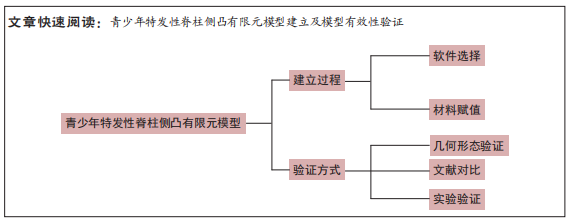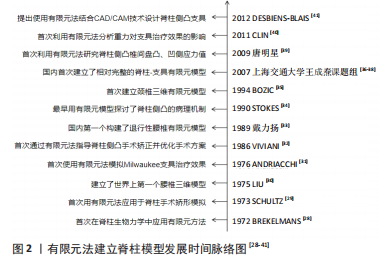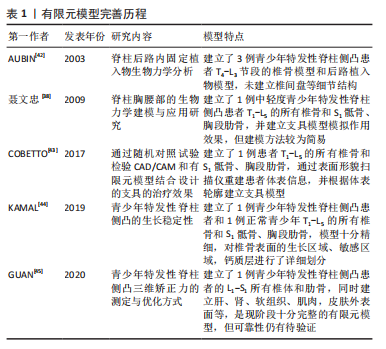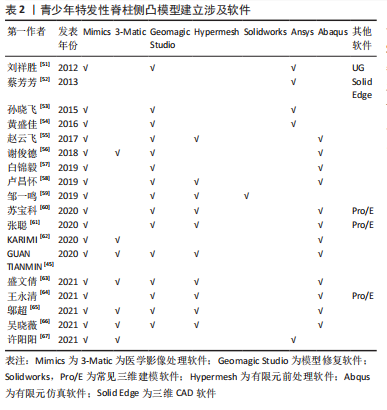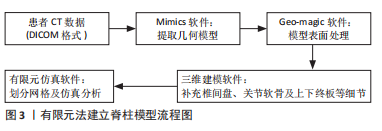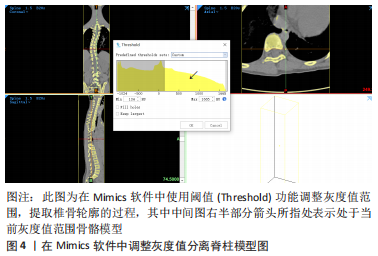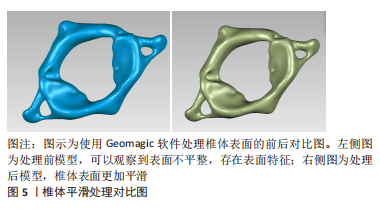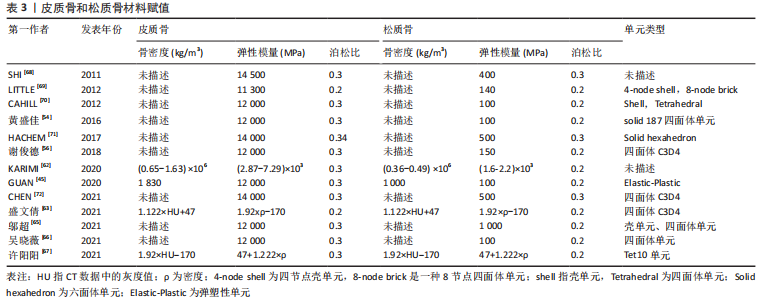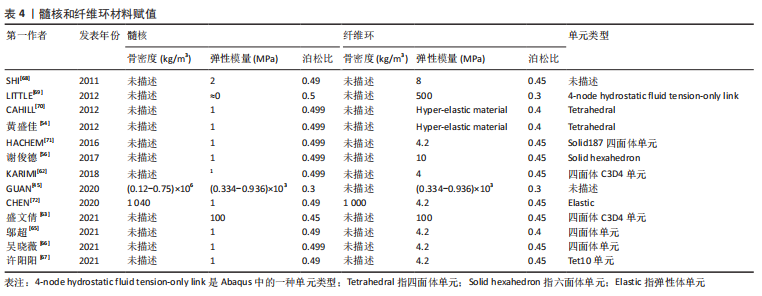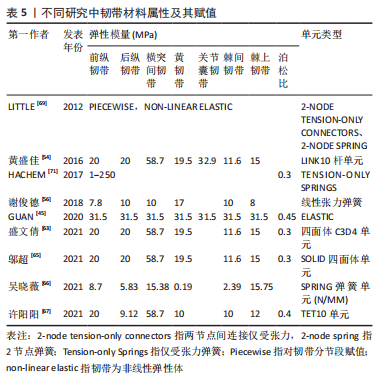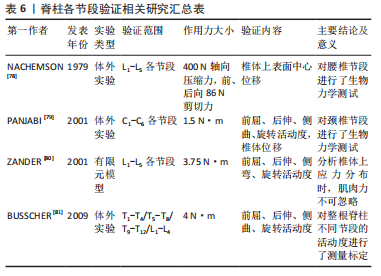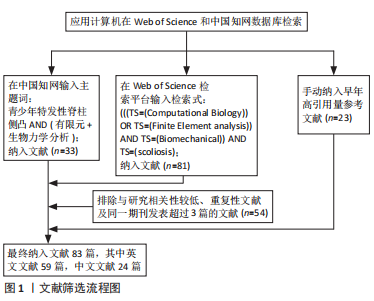[1] GOHARI E, HAGHPANAHI M, PARNIANPOUR M, et al. Numerical analysis (finite element method) of brace effects on the adolescent idiopatic scolosis during 24 hours. Biomed Eng. 2014;26(3):1450046.
[2] LI QY, ZHONG GB, LIU ZD, et al. Effect of asymmetric tension on biomechanics and metabolism of vertebral epiphyseal plate in a rodent model of scoliosis. Orthop Surg. 2017;9(3):311-318.
[3] AROEIRA RMC, PERTENCE AEM, KEMMOKU DT, et al. The effect of hypokyphosis on the biomechanical behavior of the adolescent thoracic spine. J Braz Soc Mech Sci. 2018;40(3):1-10.
[4] DUPUIS S, FORTIN C, CAOUETTE C, et al. Global postural re-education in pediatric idiopathic scoliosis: a biomechanical modeling and analysis of curve reduction during active and assisted self-correction. BMC Musculoskelet Disord. 2018;19(1):200.
[5] ZHANG Q, CHON T, ZHANG Y, et al. Finite element analysis of the lumbar spine in adolescent idiopathic scoliosis subjected to different loads. Comput Biol Med. 2021;136:104745.
[6] LALONDE NM, VILLEMURE I, PANNETIER R, et al. Biomechanical modeling of the lateral decubitus posture during corrective scoliosis surgery. Clin Biomech. 2010;25(6):510-516.
[7] DRISCOLL M, MAC-THIONG J-M, LABELLE H, et al. Development of a detailed volumetric finite element model of the spine to simulate surgical correction of spinal deformities. Biomed Res Int. 2013;2013:931741.
[8] ZHANG H, HU X, WANG Y, et al. Use of finite element analysis of a Lenke type 5 adolescent idiopathic scoliosis case to assess possible surgical outcomes. Comput Aided Surg. 2013;18(3-4):84-92.
[9] RIGO MD, VILLAGRASA M, GALLO D. A specific scoliosis classification correlating with brace treatment:description and reliability. Scoliosis. 2010;5(1):1.
[10] KING HA, MOE JH, BRADFORD DS, et al. The selection of fusion levels in thoracic idiopathic scoliosis. J Bone Joint Surg Am. 1983;65(9):1302-1313.
[11] BERTEAU JP, PITHIOUX M, MESURE S, et al. Beyond the classic correction system: a numerical nonrigid approach to the scoliosis brace. Spine J. 2011; 11(5):424-431.
[12] PÉRIÉ D, AUBIN CE, LACROIX M, et al. Personalized biomechanical modeling of boston brace treatment in idiopathic scoliosis. Stud Health Technol Inform. 2002;91:393-396.
[13] CLIN J, AUBIN C E, PARENT S, et al. Biomechanical modeling of brace design. Stud Health Technol Inform. 2006;123:255-260.
[14] FORTIN D, CHERIET F, BEAUSéJOUR M, et al. A 3D visualization tool for the design and customization of spinal braces. Comput Med Imaging Graph. 2007; 31(8):614-624.
[15] CLIN J, AUBIN CE, LABELLE H. Virtual prototyping of a brace design for the correction of scoliotic deformities. Med Biol Eng Comput. 2007;45(5):467-473.
[16] CLIN J, AUBIN CE, PARENT S, et al. Comparison of the biomechanical 3D efficiency of different brace designs for the treatment of scoliosis using a finite element model. Eur Spine J. 2010;19(7):1169-1178.
[17] VERGARI C, CHEN Z, ROBICHON L, et al. Towards a predictive simulation of brace action in adolescent idiopathic scoliosis. Comput Methods Biomech Biomed Engin. 2021;24(8):874-882.
[18] AULISA AG, MASTANTUONI G, LAINERI M, et al. Brace technology thematic series:the progressive action short brace (PASB). Scoliosis. 2012;7(1):6.
[19] AULISA AG, GUZZANTI V, FALCIGLIA F, et al. Lyon bracing in adolescent females with thoracic idiopathic scoliosis: a prospective study based on SRS and SOSORT criteria. BMC Musculoskelet Disord. 2015;16(1):316.
[20] KUROKI H. Brace treatment for adolescent idiopathic scoliosis. J Clin Med. 2018;7(6):136.
[21] KAELIN AJ. Adolescent idiopathic scoliosis:indications for bracing and conservative treatments. Ann Transl Med. 2020;8(2):28.
[22] WEISS HR, LAY M, SEIBEL S, et al. Is it possible to improve treatment safety in the brace treatment of scoliosis patients by using standardized CAD algorithms? Orthopade. 2021;50(6):435-445.
[23] SATTOUT A, CLIN J, COBETTO N, et al. Biomechanical assessment of providence nighttime brace for the treatment of adolescent idiopathic scoliosis. Spine Deform. 2016;4(4):253-260.
[24] MARTINO J, AUBIN CE, LABELLE H, et al. Biomechanical analysis of vertebral derotation techniques for the surgical correction of thoracic scoliosis. Spine. 2013;38(2):E73-E83.
[25] 李劲松.有限元法模拟特发性脊柱侧凸后路矫形及内固定应力分析研究[D].长沙:中南大学,2013.
[26] PéRIé D, AUBIN CE, PETIT Y, et al. Boston brace correction in idiopathic scoliosis: a biomechanical study. Spine. 2003;28(15):1672-1677.
[27] GUY A, LABELLE H, BARCHI S, et al. Braces designed using cad/cam combined or not with finite element modeling lead to effective treatment and quality of life after 2 years a randomized controlled trial. Spine. 2021; 46(1):9-16.
[28] BREKELMANS WA, POORT HW, SLOOFF TJ. A new method to analyse the mechanical behaviour of skeletal parts. Acta Orthop Scand. 1972;43(5):301-317.
[29] SCHULTZ AB, BELYTSCHKO TB, ANDRIACCHI TP, et al. Analog studies of forces in the human spine:mechanical properties and motion segment behavior. J Biomech. 1973;6(4):373-383.
[30] LIU YK, RAY G, HIRSCH C. The resistance of the lumbar spine to direct shear. Orthop Clin North Am. 1975;6(1):33-49.
[31] ANDRIACCHI TP, SCHULTZ AB, BELYTSCHKO TB, et al. Milwaukee brace correction of idiopathic scoliosis. A biomechanical analysis and a restrospective study. J Bone Joint Surg Am. 1976;58(6):806-815.
[32] VIVIANI GR, GHISTA DN, LOZADA PJ, et al. Biomechanical analysis and simulation of scoliosis surgical correction. Clin Orthop Relat Res. 1986;(208):40-47.
[33] 戴力扬,屠开元,徐印坎,等.椎间盘退变腰椎活动节段力学模型的研究[J].第二军医大学学报,1989,15(1):480.
[34] STOKES IA, LAIBLE JP. Three-dimensional osseo-ligamentous model of the thorax representing initiation of scoliosis by asymmetric growth. J Biomech. 1990;23(6):589-595.
[35] BOZIC KJ, KEYAK JH, SKINNER HB, et al. Three-dimensional finite element modeling of a cervical vertebra: an investigation of burst fracture mechanism. J Spinal Disord. 1994;7(2):102-110.
[36] 王哲.青少年特发性脊柱侧凸的生物力学研究[D].上海:上海交通大学,2007.
[37] 汪正宇,刘祖德,王哲,等.脊柱侧凸有限元模型的建立和参数优化[J].北京生物医学工程,2008,27(1):28-32.
[38] 聂文忠.脊柱胸腰部的生物力学建模与应用研究[D].上海:上海交通大学,2009.
[39] 唐明星. Lenke1A-型青少年特发性脊柱侧凸有限元模型建立及其生物力学研究[D].长沙:中南大学,2009.
[40] CLIN J, AUBIN CÉ, PARENT S, et al. Biomechanical modeling of brace treatment of scoliosis:effects of gravitational loads. Med Biol Eng Comput. 2011;49(7):743-753.
[41] DESBIENS-BLAIS F, CLIN J, PARENT S, et al. New brace design combining CAD/CAM and biomechanical simulation for the treatment of adolescent idiopathic scoliosis. Clin Biomech. 2012;27(10):999-1005.
[42] AUBIN CE, PETIT Y, STOKES IA, et al. Biomechanical modeling of posterior instrumentation of the scoliotic spine. Comput Methods Biomech Biomed Engin. 2003;6(1):27-32.
[43] COBETTO N, AUBIN CÉ, PARENT S, et al. 3D correction of AIS in braces designed using CAD/CAM and FEM: a randomized controlled trial. Scoliosis Spinal Disord. 2017;12(1):1-8.
[44] KAMAL Z, ROUHI G, ARJMAND N, et al. A stability-based model of a growing spine with adolescent idiopathic scoliosis: a combination of musculoskeletal and finite element approaches. Med Eng Phys. 2019;64:46-55.
[45] GUAN T, ZHANG Y, ANWAR A, et al. Determination of three-dimensional corrective force in adolescent idiopathic scoliosis and biomechanical finite element analysis. Front Bioeng Biotechnol. 2020;8:963.
[46] HENAO J, AUBIN CÉ, LABELLE H, et al. Patient-specific finite element model of the spine and spinal cord to assess the neurological impact of scoliosis correction:preliminary application on two cases with and without intraoperative neurological complications. Comput Methods Biomech Biomed Engin. 2016;19(8):901-910.
[47] AUBIN CÉ, CLIN J, RAWLINSON J. Biomechanical simulations of costo-vertebral and anterior vertebral body tethers for the fusionless treatment of pediatric scoliosis. J Orthop Res. 2018;36(1):254-264.
[48] PEA R, DANSEREAU J, CAOUETTE C, et al. Computer-assisted design and finite element simulation of braces for the treatment of adolescent idiopathic scoliosis using a coronal plane radiograph and surface topography. Clin Biomech. 2018;54:86-91.
[49] BIDARI S, KAMYAB M, GHANDHARI H, et al. Efficacy of computer-aided design and manufacturing versus computer-aided design and finite element modeling technologies in brace management of idiopathic scoliosis: a narrative review. Asian Spine J. 2021;15(2):271-282.
[50] VERGARI C, GAUME M, PERSOHN S, et al. From in vitro evaluation of a finite element model of the spine to in silico comparison of spine instrumentations. J Mech Behav Biomed Mater. 2021;123:104797.
[51] 刘祥胜.Lenke 2型特发性脊柱侧凸有限元建模及三维矫形手术的有限元模拟研究[D].上海:第二军医大学,2012.
[52] 蔡芳芳,孙东明,解京明,等.L1-L5段腰椎简化模型的建立及其有效性验证[J].第二军医大学学报,2013,34(12):1384-1386.
[53] 孙晓飞.重度青少年特发性脊柱侧凸主胸弯节段柔韧性评估及有限元分析[D].上海:第二军医大学,2015.
[54] 黄盛佳,霍洪军,杨学军,等.PUMCⅡd1型青少年特发性脊柱侧凸后路三维矫形手术有限元研究[J].国际骨科学杂志,2016,37(1):46-52.
[55] 赵云飞.力学性能优化的青少年特发性脊柱侧凸三维有限元模型建立及置钉策略的生物力学和临床回顾研究[D].上海:第二军医大学,2017.
[56] 谢俊德,张顺心,李晔,等.青少年特发性侧凸脊柱的动态特性[J].医用生物力学,2018,33(4):312-319.
[57] 白锦毅.人体动态生物力学优化的Lenke 1型青少年特发性脊柱侧凸仿真三维有限元模型的建立[D].上海:中国人民解放军海军军医大学, 2019.
[58] 卢昌怀,刘志军,晏峻峰,等.Lenke 1AN型青少年特发性脊柱侧凸不同置棒顺序矫形的有限元分析[J].中国矫形外科杂志,2019,27(19):1780-1784.
[59] 邹一鸣.青少年特发性脊柱侧凸手术置钉策略优化的生物力学研究[D].上海:中国人民解放军海军军医大学,2019.
[60] 苏宝科.青少年特发性脊柱侧凸Lenke5型胸腰段矫形后有限元分析[D].呼和浩特:内蒙古医科大学,2020.
[61] 张聪,赵岩,杜小宇,等.青少年特发性脊柱侧凸腰主弯患者腰椎-骨盆的生物力学分析[J].中国组织工程研究,2020,24(8):1155-1161.
[62] KARIMI MT, RABCZUK T, POURABBAS B. Evaluation of the efficiency of various force configurations on scoliotic, lordotic and kyphotic curves in the subjects with scoliosis. Spine Deform. 2020;8(3):361-367.
[63] 盛文倩.个性化脊柱侧凸的有限元建模和分析[D].太原:太原理工大学, 2021.
[64] 王永清,苏宝科,王威,等.青少年特发性脊柱侧凸Lenke5型胸腰段后路矫形后钛棒有限元分析[J].中国当代医药,2021,28(6):4-7,16,241-242.
[65] 邬超,高明杰,王建忠,等.有限元法分析Lenke 3型青少年特发性脊柱侧凸胸-腰椎的应力及位移变化[J].中国组织工程研究,2021,25(33): 5273-5280.
[66] 吴晓薇.轻度青少年特发性脊柱侧凸的三维有限元模型构建及有效性验证[D].广州:南方医科大学,2021.
[67] 许阳阳,李筱贺,李志军,等. Lenke 1型青少年特发性脊柱侧凸与正常脊柱有限元模型建立与分析[J].解剖学杂志,2021,44(2):140-146.
[68] SHI L, WANG D, DRISCOLL M, et al. Biomechanical analysis and modeling of different vertebral growth patterns in adolescent idiopathic scoliosis and healthy subjects. Scoliosis. 2011;6:11.
[69] LITTLE JP, ADAM C. Towards determining soft tissue properties for modelling spine surgery:current progress and challenges. Med Biol Eng Comput. 2012; 50(2):199-209.
[70] CAHILL PJ, WANG W, ASGHAR J, et al. The use of a transition rod may prevent proximal junctional kyphosis in the thoracic spine after scoliosis surgery a finite element analysis. Spine. 2012;37(12):E687-695.
[71] HACHEM B, AUBIN C-E, PARENT S. Porcine spine finite element model: a complementary tool to experimental scoliosis fusionless instrumentation. Eur Spine J. 2017;26(6):1610-1617.
[72] CHEN K, ZHAO J, ZHAO Y, et al. A finite element analysis of different pedicle screw placement strategies for treatment of Lenke 1 adolescent idiopathic scoliosis: which is better?. Comput Methods Biomech Biomed Engin. 2021; 24(3):270-277.
[73] 李文成.脊柱矫正力的计算与分析[D].大连:大连交通大学,2018.
[74] JAREMKO JL, PONCET P, RONSKY J, et al. Estimation of spinal deformity in scoliosis from torso surface cross sections. Spine. 2001;26(14):1583-1591.
[75] PAZOS V, CHERIET F, SONG L, et al. Accuracy assessment of human trunk surface 3D reconstructions from an optical digitising system. Med Biol Eng Comput. 2005;43(1):11-15.
[76] PAZOS V, CHERIET F, DANSERAU J, et al. Reliability of trunk shape measurements based on 3-D surface reconstructions. Eur Spine J. 2007; 16(11):1882-1891.
[77] HUI C, PIAO J, WONG M S, et al. Study of textile fabric materials used in spinal braces for scoliosis. J Med Biol Eng. 2020;40:356-371.
[78] NACHEMSON AL, SCHULTZ AB, BERKSON MH. Mechanical properties of human lumbar spine motion segments. Influence of age, sex, disc level, and degeneration. Spine. 1979;4(1):1-8.
[79] PANJABI MM, CHEN NC, SHIN EK, et al. The cortical shell architecture of human cervical vertebral bodies. Spine. 2001;26(22):2478-2484.
[80] ZANDER T, ROHLMANN A, CALISSE J, et al. Estimation of muscle forces in the lumbar spine during upper-body inclination. Clin Biomech. 2001;16:S73-S80.
[81] BUSSCHER I, VAN DIEËN JH, KINGMA I, et al. Biomechanical characteristics of different regions of the human spine: an in vitro study on multilevel spinal segments. Spine. 2009;34(26):2858-2864.
[82] VERGARI C, RIBES G, AUBERT B, et al. Evaluation of a patient-specific finite-element model to simulate conservative treatment in adolescent idiopathic scoliosis. Spine Deform. 2015;3(1):4-11.
[83] GOULD SL, CRISTOFOLINI L, DAVICO G, et al. Computational modelling of the scoliotic spine: a literature review. Int J Numer Method Biomed Eng. 2021;37(10):e3503. |
